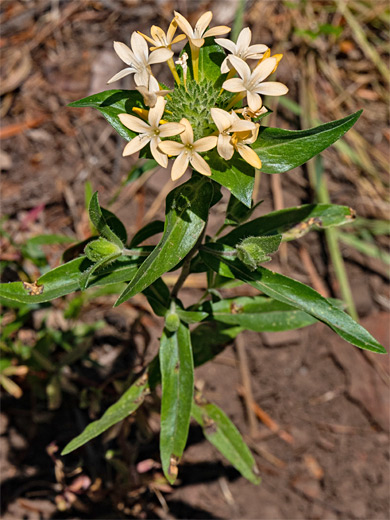Collomia Grandiflora, Large-flowered Collomia
Plants > Wildflowers > Polemoniaceae > Collomia Grandiflora
Common names:
Large-flowered collomia, large-flowered mountain trumpet
Family:
Scientific name:
Collomia Grandiflora
Main flower color:
Range:
The Rocky Mountains, and all states to the west
Height:
Up to 20 inches
Habitat:
Open slopes and flats, often shaded locations, from near sea level to 9,000 feet
Leaves:
Alternate, entire, narrowly lanceolate at the base becoming linear up the stem. Mostly hairless; sometimes slightly glandular hairy on the undersides
Season:
May to August
Leaves of collomia grandiflora are bright green, somewhat shiny, and held at a 90 degree angle from the stem, which is usually unbranched. They are relatively widely separated, and alternately arranged, from near the base all the way to the tip, right below the flowers.
The inflorescence is a compact, spherical cluster, terminal and sometimes also from the uppermost leaf nodes, with flowers opening in stages starting from the outside. Corollas have a narrow, yellow-orange tube, up to one inch long, opening to five spreading, lanceolate lobes, pale orange to nearly white. The outer surface of the corolla is sparsely covered by short, glandular hairs. The five stamens have white filaments and blueish anthers. Flowers are sessile.
Occasionally plants are cleistogamous, self-pollinating, in which case the flowers are much smaller, and the stem shorter.
The inflorescence is a compact, spherical cluster, terminal and sometimes also from the uppermost leaf nodes, with flowers opening in stages starting from the outside. Corollas have a narrow, yellow-orange tube, up to one inch long, opening to five spreading, lanceolate lobes, pale orange to nearly white. The outer surface of the corolla is sparsely covered by short, glandular hairs. The five stamens have white filaments and blueish anthers. Flowers are sessile.
Occasionally plants are cleistogamous, self-pollinating, in which case the flowers are much smaller, and the stem shorter.
All Contents © Copyright The American Southwest | Comments and Questions | Contribute | Site Map


